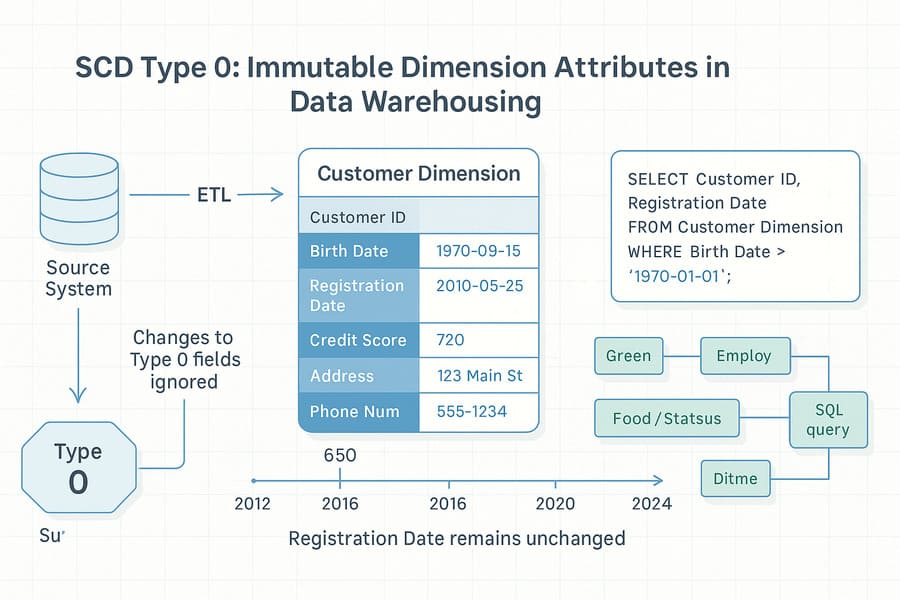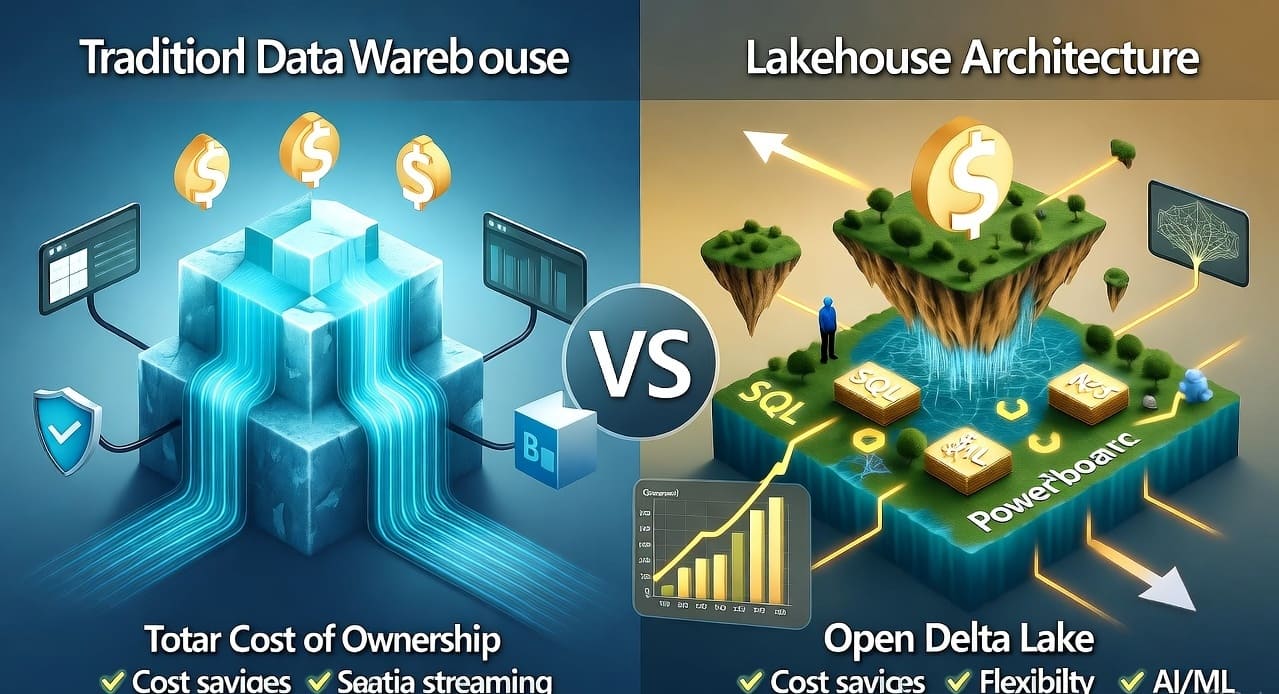SCD Type 0: Retain Original – Immutable Dimensions in Data Warehousing
In the nuanced world of data warehouse design, effectively managing changing dimension attributes is a fundamental challenge that data engineers face daily. Among the various Slowly Changing Dimension (SCD) methodologies, Type 0 stands apart with its uncompromising simplicity: never change the original values, regardless of real-world changes. This “retain original” approach might seem basic at first glance, but its applications and implications are surprisingly sophisticated and far-reaching.
Understanding SCD Type 0: The Principle of Immutability
SCD Type 0 is defined by a single, unwavering principle: once a dimensional attribute value is recorded, it remains unchanged for the entire lifecycle of the dimension record. This steadfast immutability distinguishes Type 0 from other SCD types that accommodate change in various ways.
Core Characteristics of SCD Type 0
The defining characteristics that make Type 0 unique in the SCD taxonomy include:
- Complete Immutability: Values are written once and never modified
- No Historical Tracking: No mechanism for recording changes, as changes simply aren’t allowed
- Original Values Preserved: The first recorded value is maintained permanently
- Change Rejection: Updates to the source system are intentionally ignored
- Static Truth Definition: The dimension represents a specific point-in-time reality that never evolves
Conceptual Example: Customer Dimension
To illustrate the concept, consider a customer dimension where certain attributes are implemented as Type 0:
CustomerDimension {
CustomerKey (PK)
CustomerID
FirstName // Type 0: Never changes
LastName // Type 1: Can be updated
DateOfBirth // Type 0: Never changes
OriginalCreditScore // Type 0: Score at first application
CurrentCreditScore // Type 1: Updated score
CustomerAddress // Type 2: Full history tracked
RegistrationDate // Type 0: Never changes
CustomerSegment // Type 1: Can be updated
}
In this example, FirstName, DateOfBirth, OriginalCreditScore, and RegistrationDate are Type 0 attributes—they will never change regardless of updates in source systems.
When to Apply SCD Type 0: Strategic Use Cases
While the concept is straightforward, the strategic application of Type 0 requires careful consideration. Here are the primary scenarios where Type 0 attributes deliver significant value:
1. Inherently Immutable Properties
Some attributes are immutable by their very nature:
- Birth Date: A person’s date of birth doesn’t change
- Creation Timestamps: When an entity was first created
- Original Documentation: Initial application forms or registration details
- Physical Constants: Properties that cannot change (manufacturing date, serial number)
2. Original State Preservation
Retaining initial values provides critical baseline reference points:
- Initial Credit Scores: Original creditworthiness at account opening
- Starting Measurements: Initial health metrics for medical patients
- Baseline Configurations: Original settings of equipment or systems
- Initial Classifications: Original risk categories or segments
3. Tracking Constants for Analytical Stability
Some attributes should remain constant for analytical consistency:
- Cohort Assignments: Customer acquisition channels or cohort groupings
- Geographical Origins: Original store where customer first purchased
- Initial Categorizations: Original product category assignments
- Entry Point Tracking: Original touchpoint in the customer journey
4. Compliance and Audit Requirements
Regulatory needs often require preservation of original values:
- KYC Information: Original identity verification data
- Legal Agreements: Terms accepted at registration
- Regulatory Filings: Original submitted information
- Contractual Terms: Original agreement parameters
Technical Implementation: Building Type 0 Attributes
Implementing Type 0 attributes requires specific technical approaches to ensure their immutability is maintained throughout the data pipeline.
ETL/ELT Implementation Patterns
The following patterns ensure Type 0 attributes maintain their immutability:
Initial Load Pattern
During the first load of a dimension record:
- Extract the attribute from the source system
- Perform any necessary cleansing or standardization
- Load the value into the dimension table
Subsequent Update Pattern
When processing updates to existing dimension records:
- Load all non-Type 0 attributes normally
- For Type 0 attributes, use one of these approaches:
- Explicitly exclude Type 0 columns from update statements
- Read existing values and write them back unchanged
- Use conditional logic to only update non-Type 0 attributes
SQL Implementation Example
-- Initial dimension load
INSERT INTO DimCustomer (
CustomerID,
FirstName, -- Type 0
LastName, -- Type 1
DateOfBirth, -- Type 0
CustomerAddress, -- Type 2
RegistrationDate -- Type 0
)
SELECT
CustomerID,
FirstName,
LastName,
DateOfBirth,
Address,
RegistrationDate
FROM StageCustomer;
-- Subsequent Type 1 updates (preserving Type 0 attributes)
UPDATE DimCustomer
SET
LastName = S.LastName
FROM StageCustomer S
WHERE DimCustomer.CustomerID = S.CustomerID
AND (DimCustomer.LastName <> S.LastName);
-- Type 2 updates handled separately with new rows
Data Modeling Considerations
When incorporating Type 0 attributes into your dimensional model:
- Clearly Document Type 0 Attributes: Ensure all team members know which attributes should never change
- Consider Column Grouping: Group Type 0 attributes together for clarity
- Use Naming Conventions: Prefixes like “Original_” can signal Type 0 attributes
- Apply Database Constraints: Consider using triggers or constraints to prevent updates
Handling Source System Changes
Despite the “never change” rule, real-world scenarios sometimes require strategies for addressing source system modifications:
- Source Error Corrections: Have a governed exception process for correcting genuine data entry errors
- Default Value Handling: Establish policies for handling initially null values that later receive data
- Data Quality Monitoring: Implement alerts for attempted changes to Type 0 attributes
- Change Logging: Consider logging attempted changes for audit purposes even if not applied
Type 0 in Context: Comparison with Other SCD Types
To fully appreciate the role of Type 0, it’s valuable to contrast it with other SCD methodologies:
Type 0 vs. Type 1 (Overwrite)
| Aspect | Type 0 (Retain Original) | Type 1 (Overwrite) |
|---|---|---|
| Value Changes | Never change | Overwrite with new values |
| Historical Data | Original values only | Current values only |
| Query Complexity | Simple | Simple |
| Storage Impact | Minimal | Minimal |
| Implementation Complexity | Very low | Low |
| Use Case | Immutable properties | Current state only matters |
Type 0 vs. Type 2 (Add New Row)
| Aspect | Type 0 (Retain Original) | Type 2 (Add New Row) |
|---|---|---|
| Value Changes | Never change | New row with new values |
| Historical Data | Original values only | Complete history |
| Query Complexity | Simple | Moderate |
| Storage Impact | Minimal | Significant |
| Implementation Complexity | Very low | Moderate to high |
| Use Case | Immutable properties | Full historical tracking needed |
Type 0 vs. Type 6 (Hybrid)
| Aspect | Type 0 (Retain Original) | Type 6 (Hybrid) |
|---|---|---|
| Value Changes | Never change | Complex change tracking |
| Historical Data | Original values only | Complete + current flags |
| Query Complexity | Simple | Complex |
| Storage Impact | Minimal | Significant |
| Implementation Complexity | Very low | High |
| Use Case | Immutable properties | Maximum flexibility needed |
Hybrid Approaches: Combining Type 0 with Other SCD Types
In practice, most dimensions contain attributes handled with different SCD types. Type 0 often complements other SCD strategies:
Type 0 + Type 1 Combination
A common pattern preserving original values while maintaining current state:
CustomerDimension {
CustomerKey (PK)
CustomerID
Original_CreditScore // Type 0: Never changes
Current_CreditScore // Type 1: Updated with current value
Original_Address // Type 0: First address
Current_Address // Type 1: Current address
Registration_Date // Type 0: Never changes
}
This approach enables both “as of now” and “as of registration” analysis without the complexity of Type 2.
Type 0 + Type 2 Combination
When full history is needed for some attributes but original values must be preserved:
CustomerDimension {
CustomerKey (PK)
CustomerID
Original_Segment // Type 0: Original segment
Customer_Segment // Type 2: Full history of segments
EffectiveDate
ExpirationDate
Current_Flag
}
This combination is powerful for cohort analysis that needs to compare current state against original classification.
Type 0 in Type 6 Implementations
Type 6 (the “hybrid” approach combining Types 1, 2, and 3) often incorporates Type 0 attributes as reference points:
ProductDimension {
ProductKey (PK)
ProductID
LaunchDate // Type 0: Never changes
CurrentProductName // Type 1: Current name
ProductName // Type 2: Historical names
OriginalCategory // Type 0: Original category
PreviousCategory // Type 3: Previous category
CurrentCategory // Type 1: Current category
EffectiveDate
ExpirationDate
Current_Flag
}
Advanced Applications: Type 0 in Modern Data Architectures
The principle of immutability in Type 0 dimensions aligns well with modern data architecture patterns:
Data Vault Integration
In Data Vault modeling, Type 0 attributes align with:
- Hub Records: Business keys in hubs are inherently Type 0
- Historical Satellites: Original state satellites preserve first values
- Reference Satellites: Static classification satellites
Event-Sourced Systems
Type 0 complements event sourcing by:
- Preserving original event properties
- Maintaining immutable event records
- Supporting event replay with original values
Data Lake Implementations
In data lake architectures, Type 0 principles manifest as:
- Immutable raw data zones
- Original record preservation
- Bronze layer immutability
Streaming Data Processing
Type 0 concepts apply to streaming scenarios through:
- Original event retention
- Immutable event logs (like Kafka)
- First-seen attribute extraction
Performance and Storage Considerations
While Type 0 is conceptually simple, its implementation has notable performance and storage implications:
Storage Efficiency
Type 0 attributes are storage-efficient because:
- No historical versions needed
- No additional tracking columns required
- No temporal overlap considerations
Query Performance
Queries involving Type 0 attributes benefit from:
- No temporal filtering required
- Simpler join conditions
- No current_flag or date range predicates
- Better index utilization
Data Lineage Simplification
Type 0 simplifies data lineage tracking by:
- Eliminating change tracking complexity
- Providing consistent reference points
- Simplifying historical reconstructions
Real-World Implementation Example: Financial Services
To illustrate a practical implementation of Type 0, consider a financial services customer dimension:
Account Dimension with Mixed SCD Types
DimAccount {
AccountKey (PK)
AccountID (Natural Key)
// Type 0 Attributes - Never Change
OpenDate
OriginalProduct
OriginalBranch
OriginalCreditLimit
OriginalInterestRate
SourceSystem
// Type 1 Attributes - Current Values Only
CurrentCreditLimit
CurrentInterestRate
AccountStatus
// Type 2 Attributes - Full History
OwnershipType
AccountManager
RiskCategory
EffectiveDate
ExpirationDate
Current_Flag
}
This design enables crucial financial analytics:
- Compare original vs. current interest rates across cohorts
- Analyze account performance based on original branch
- Track risk category changes while retaining original classifications
- Measure credit limit increases from original baselines
Implementation Best Practices
To successfully implement Type 0 attributes, consider these best practices:
1. Explicit Documentation
Clearly identify Type 0 attributes in:
- Data dictionaries
- ETL specifications
- Data governance policies
- Data warehouse documentation
2. Business Rule Validation
Confirm immutability requirements through:
- Business stakeholder validation
- Regulatory requirement review
- Use case confirmation
- Change scenario analysis
3. Exception Handling
Establish processes for the rare cases when Type 0 attributes might need correction:
- Data quality remediation procedures
- Executive approval processes
- Change audit logging
- Updated value annotations
4. Monitoring and Enforcement
Implement safeguards to protect Type 0 integrity:
- Data quality monitoring
- Change attempt alerting
- ETL validation rules
- Database triggers or constraints
5. Clear Naming Conventions
Adopt naming standards that signal immutability:
- Prefix: “Original_” or “Initial_”
- Suffix: “_At_Registration”
- Documentation tags in metadata repositories
- Comments in DDL scripts
Conclusion: The Strategic Value of Simplicity
In the complex landscape of data warehouse design, SCD Type 0 represents a powerful reminder that sometimes the simplest approach delivers the most value. By permanently retaining original values for selected attributes, organizations gain multiple benefits:
- Analytical Consistency: Fixed reference points that never change
- Implementation Simplicity: The easiest SCD type to implement
- Query Performance: Efficient retrieval without temporal complexities
- Business Clarity: Clear representation of original states
While not suitable for all attributes, Type 0 plays a crucial role in a comprehensive dimensional modeling strategy. The “retain original” approach provides the foundation upon which other SCD types can build, enabling both simplified current-state reporting and sophisticated historical analysis.
For data engineers and architects designing data warehouses, mastering the strategic application of Type 0 attributes is an essential skill that enhances both model integrity and analytical capabilities. In a data landscape constantly navigating the challenges of change, sometimes the most powerful approach is to anchor certain elements in their original, unchanging state.
Keywords: SCD Type 0, Slowly Changing Dimensions, retain original, immutable dimensions, data warehouse design, dimensional modeling, original values, reference data, data warehousing, ETL processing, immutability, Kimball methodology, customer dimension, data integration, historical data
Hashtags: #SCDType0 #SlowlyChangingDimensions #DataWarehouse #DimensionalModeling #DataEngineering #ETLProcessing #Immutability #OriginalValues #DataIntegration #KimballMethodology #DataArchitecture #BusinessIntelligence #Analytics #DataStrategy #ReferenceData





